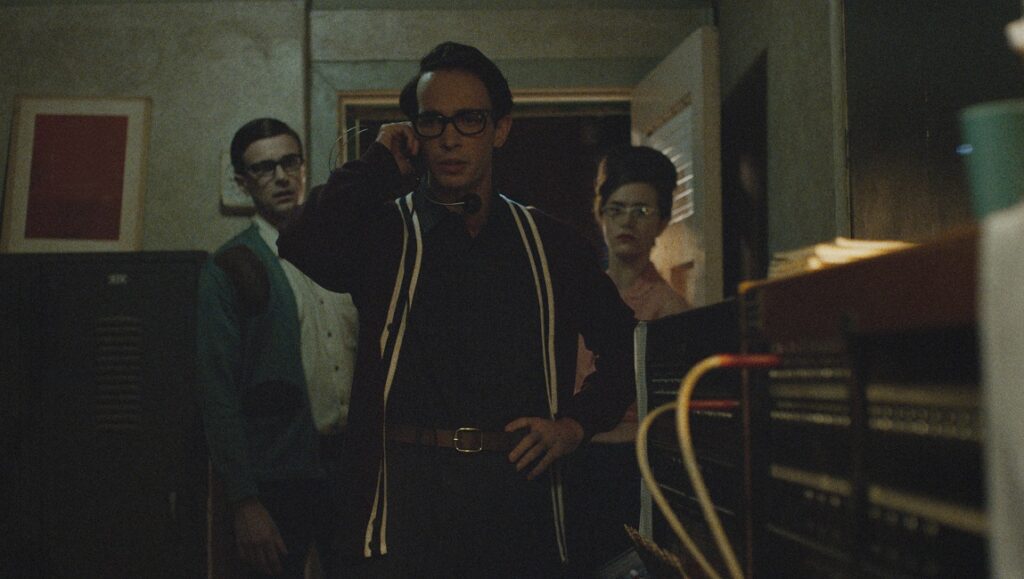The Vast of Night opens with an assured and prefatory walk-and-talk, an extended tracking shot that first follows first Everett (Jake Horowitz), a local radio show host, and then adds Fay (Sierra McCormick), a student and switchboard operator — both young residents of 1950s Cayuga, NM. Not only does this formal choice introduce us to the principals (he, a quick and slick charmer, preternaturally professional and with ambition to burn; she, a techno geek, thumbing science magazines for fun and keenly aware of her oddball status), but it also orients to a specific place and time. The pair wanders in this unbroken shot and the camera pursues, as the town’s compact geography and mood begin to clarify. Our starting point is the school gymnasium, the bleachers riotous in the wake of the basketball season’s first game, colorful residents,descending upon the meager evening entertainment. Everett and Fay exit the din and pomp of pre-game revelry for the headlight-lit parking lot, and eventually the small town city streets, empty beneath a sky dense with dark in an era absent of light pollution. The Vast of Night is also genre fare, a context signaled immediately – debut director Andrew Patterson situates his film as a Twilight Zone riff, only here titled Paradox Theater, and The Vast of Night is presented as an ostensible episode. Opening to the image of an old-timey cathode-ray tube television, all rounded edges and wood panel trim, the camera then proceeds to zoom and colorize and unfuzz, passing into the TV, so to speak, and commencing the film in earnest.
Patterson integrates these spurts of deceptive, practical complexity into patient long takes, a strategy which forces viewers to recondition the modes in which they movie-watch, developing and trusting the character dynamism and intensely purposeful mise en scene rather than getting bogged down in any rehash of cockamamie alien chestnuts.
This entire set up, and the actors who sell it, demonstrates a remarkable confidence: Patterson saturates his visuals with period-specific flourishes, and prizes specificity (the culturally-bred stoicism of women, the risk of giving voice to black men on the radio) without ever descending into cheap nostalgia. The Vast of Night’s influences and touchstones — H.G. Wells, Rod Serling, Roswell lore, Invasion of the Body Snatchers, Red Scare propaganda – are varyingly inter-, extra-, and subtextual, both interacting with existing material and subverting familiar expectations. But this is micro-budget cinema, something reminiscent of a lo-fi Stranger Things by way of Primer, and Patterson’s greatest trick, in defiance of budgetary limitations, is to perfect the movement and manner of his film’s kinetic action: both the blocking and choreography are consistently striking, and exhibit a theatrical understanding of the veritable stage, and the clear standout sequence is built on a prolonged medium-closeup of a switchboard, Fay’s movements and mindset increasingly frenetic even as she artfully manages the patches and plugs with something like balletic grace. Patterson integrates these spurts of deceptive, practical complexity into patient long takes, a strategy which forces viewers to recondition the modes in which they movie-watch, developing and trusting the character dynamism and intensely purposeful mise en scene rather than getting bogged down in any rehash of cockamamie alien chestnuts. A return to the represented era’s understanding of science fiction as a genre built on disquiet, and the intrusion of the unknown, The Vast of Night does not just upend its minimalist genesis, but also subsumes its spirit — and in the service of creating something grand from its well-worn parts.
You can currently stream Andrew Patterson’s The Vast of Night on Amazon.


Comments are closed.